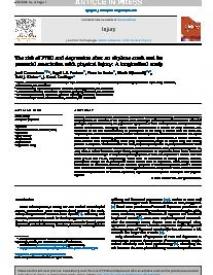The risk of PTSD and depression after an airplane crash and its potential association with physical injury: A longitudinal study
In 2009, a commercial airplane crashed near Amsterdam. This longitudinal study aims to investigate (1)
the proportion of survivors of the airplane crash showing a probable posttraumatic stress disorders
(PTSD) or depressive disorder, and (2) whether symptoms of PTSD and depression were predicted by
trauma characteristics. Identifying these trauma characteristics is crucial for early detection and
treatment. Of the 121 adult survivors, 82 participated in this study 2 months after the crash and
76 participated 9 months after the crash. Risk for PTSD and depression was measured with the self-report
instruments Trauma Screening Questionnaire and Patient Health Questionnaire-2. Trauma characteristics
assessed were Injury Severity Score (ISS), hospitalisation, length of hospital stay, and seating
position in the plane. Two months after the crash, 32 participants (of N = 70, 46%) were at risk for PTSD
and 28 (of N = 80, 32%) were at risk for depression. Nine months after the crash, 35 participants (of N = 75,
47%) were at risk for PTSD and 24 (of N = 76, 35%) were at risk for depression. There was a moderate
correlation between length of hospital stay and symptoms of PTSD and depression 9 months after the
crash (r = .33 and r = .45, respectively). There were no differences in seating position between
participants at high risk vs. participants at low risk for PTSD or depression. Mixed design ANOVAs
showed also no association between the course of symptoms of PTSD and depression 2 and 9 months
after the crash and ISS or hospitalisation. This suggests that health care providers need to be aware that
survivors may be at risk for PTSD or depression, regardless of the objective severity of their physical
injuries.
Geachte bezoeker,
De informatie die u nu opvraagt, kan door psychotraumanet niet aan u worden getoond. Dit kan verschillende redenen hebben,
waarvan (bescherming van het) auteursrecht de meeste voorkomende is. Wanneer het mogelijk is om u door te verwijzen naar de bron
van deze informatie, dan ziet u hier onder een link naar die plek.
Als er geen link staat, kunt u contact opnemen met de bibliotheek,
die u verder op weg kan helpen.
Met vriendelijke groet,
Het psychotraumanet-team.
Reference:
Juul Gouweloos, Ingri L.E. Postma, Hans te Brake, Marit Sijbrandij,
Rolf J. Kleber, & Carel Goslings | 2016
In: Injury : international journal of the care of the injured, ISSN 0020-1383 | 47 | 1 | januari | 250-256
http://www.sciencedirect.com/science/article/pii/S0020138315004167
In: Injury : international journal of the care of the injured, ISSN 0020-1383 | 47 | 1 | januari | 250-256
http://www.sciencedirect.com/science/article/pii/S0020138315004167


